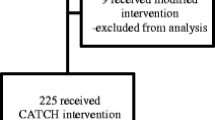Abstract
Ensuring continuity of and retention in care after release from prison is critical for optimizing health outcomes among people living with HIV. As part of a large federal initiative, we conducted qualitative interviews (n = 24) with individuals living with HIV and recently released from prison in four states to understand their experiences in different navigation interventions to improve access to HIV care post-release. Interventions were delivered only in prison, only in the community, or in both settings. While the interventions varied by design, overall, participants appreciated the breadth of support received from interventionists, including health system navigation, case management and social support. Even when individuals leaving prison were returning to clinics that they were familiar with, systems navigation supported continuity of care. Our findings elucidate why navigational support was instrumental, and underscore the value of a variety of types of navigation programs in facilitating continuity of care and reintegration post-prison.
Similar content being viewed by others
References
Spaulding AC, Seals RM, Page MJ, et al. HIV/AIDS among inmates of and releasees from US correctional facilities, 2006: declining share of epidemic but persistent public health opportunity. PLoS ONE. 2009;4(11):e7558.
Iroh PA, Mayo H, Nijhawan AE. The HIV care cascade before, during and after incarceration: a systematic review. Am J Public Health. 2015;105(7):e5–7.
Baillargeon J, Giordano TP, Rich JD, et al. Accessing ART following release from prison. JAMA. 2009;301(8):848–57.
Leukefeld CG, Hiller ML, Webster JM, et al. A prospective examination of high-cost health services utilization among drug using prisoners reentering the community. J Behav Health Serv Res. 2006;33(1):73–85.
Binswanger IA, Stern MF, Deyo RA, et al. Release from prison—a high risk of death for former inmates. N Engl J Med. 2007;356(2):157–65.
Cohen MS, Chen YQ, McCauley M, et al. Antiretroviral therapy for the prevention of HIV-1 transmission. N Engl J Med. 2016;375(9):830–9.
Springer SA, Spaulding AC, Meyer JP, Altice FL. Public health implications for adequate transitional care for HIV-infected prisoners: five essential components. Clin Infect Dis. 2011;53(5):469–79.
Meyer JP, Chen NE, Springer SA. HIV treatment in the criminal justice system: critical knowledge and intervention gaps. AIDS Res Treat. 2011;2011:680617.
SPNS Initiative: Systems Linkages and Access to Care, 2011–2016. HIV/AIDS Bureau. 2016 Hab.hrsa.gov. https://hab.hrsa.gov/about-ryan-white-hivaids-program/spns-systems-linkages-and-access (Accessed 8 December 2016).
Koester KA, Fuller SM, Maiorana A, et al. Implementing multi-level interventions to improve HIV testing, linkage-to- and retention-in-care interventions. J Health Care Poor Underserved. 2016;27(3):1234–51.
Ritchie J, Spencer L. Qualitative data analysis for applied policy research. In: Bryman A, Burgess RG, editors. Analyzing Qualitative Data. London: Routledge; 1993.
Dedoose Version 6.1.18, web application for managing, analyzing, and presenting qualitative and mixed method research data (2015). Los Angeles, CA: SocioCultural Research Consultants, LLC. Available at: www.dedoose.com.
Koester KA, Morewitz M, Pearson C, et al. Patient navigation facilitates medical and social services engagement among HIV-infected individuals leaving jail and returning to the community. AIDS Patient Care STDS. 2014;28(3):82–90.
Hammett TM, Donahue S, LeRoy L, et al. Transitions to care in the community for prison releases with HIV: a qualitative study of facilitators and challenges in two states. J Urban Health. 2015;2(4):650–66.
Bracken N, Hillard C, McCuller WJ, Harawa NT. Facilitators of HIV medical care engagement among former prisoners. AIDS Educ Prev. 2015;27(6):566–83.
Ko NY, Liu HY, Lai YY, Pai YH, Ko WC. Case management interventions for HIV-infected individuals. Curr HIV/AIDS Rep. 2013;10(4):390–7.
Montague BT, Rosen DL, Sammartino C, et al. Systematic assessment of linkage to care for persons with HIV released from corrections facilities using existing datasets. AIDS Patient Care STDs. 2016;30(2):84–91.
Wallace D, Fahmy C, Cotton L, et al. Examining the role of familial support during prison and after release on post-incarceration mental health. Int J Ther Comp Criminol. 2016;60(1):3–20.
Rozanova J, Brown SE, Bhushan A, Marcus R, Altice FL. Effect of social relationships on antiretroviral medication adherence for people living with HIV and substance use disorders and transitioning from prison. Health Justice. 2015;3:18.
Bradley H, Viall AH, Wortley PM, Dempsey A, Hauck H, Skarbinski J. Ryan White HIV/AIDS program assistance and HIV treatment outcomes. Clin Infect Dis. 2016;62(1):90–8.
Harzke AJ, Ross MW, Scott DP. Predictors of post-release primary care utilization among HIV-positive prison inmates: a pilot study. AIDS Care. 2006;18(4):290–301.
Acknowledgements
This project was supported by the Health Resources and Services Administration (HRSA) of the U.S. Department of Health and Human Services (HHS) under grant number U90HA22702 for the Systems Linkages and Access to Care for Populations at High Risk for HIV Infection Initiative Evaluation and Technical Assistance Center. This information or content and conclusions are those of the authors and should not be construed as the official position or policy of, nor should any endorsements be inferred by HRSA, HHS or the U.S. Government.
Author information
Authors and Affiliations
Corresponding author
Ethics declarations
Conflict of interest
The authors declare that they have no conflict of interest.
Ethical Approval
All procedures involving human participants were in accordance with the ethical standards for the institutional review board and with the 1964 Helsinki declaration and its later amendments or comparable ethical standards.
Informed Consent
Informed consent was obtained from all individual participants included in the study. No personal identifying information is included in the manuscript.
Rights and permissions
About this article
Cite this article
Fuller, S.M., Koester, K.A., Maiorana, A. et al. “I don’t have to do this all by myself”: Systems Navigation to Ensure Continuity of HIV Care for Persons Leaving Prison. AIDS Behav 23 (Suppl 1), 14–24 (2019). https://doi.org/10.1007/s10461-018-2050-4
Published:
Issue Date:
DOI: https://doi.org/10.1007/s10461-018-2050-4




